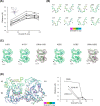Structures of oxygen dissociation intermediates of 400 kDa V2 hemoglobin provide coarse snapshots of the protein allostery
- PMID: 35797404
- PMCID: PMC9173864
- DOI: 10.2142/biophysico.bppb-v19.0019
Structures of oxygen dissociation intermediates of 400 kDa V2 hemoglobin provide coarse snapshots of the protein allostery
Abstract
Ever since the historic discovery of the cooperative oxygenation of its multiple subunits, hemoglobin (Hb) has been among the most exhaustively studied allosteric proteins. However, the lack of structural information on the intermediates between oxygenated and deoxygenated forms prevents our detailed understanding of the molecular mechanism of its allostery. It has been difficult to prepare crystals of intact oxy-deoxy intermediates and to individually identify the oxygen saturation for each subunit. However, our recent crystallographic studies have demonstrated that giant Hbs from annelids are suitable for overcoming these problems and can provide abundant information on oxy-deoxy intermediate structures. Here, we report the crystal structures of oxy-deoxy intermediates of a 400 kDa Hb (V2Hb) from the annelid Lamellibrachia satsuma, following up on a series of previous studies of similar giant Hbs. Four intermediate structures had average oxygen saturations of 78%, 69%, 55%, and 26%, as determined by the occupancy refinement of the bound oxygen based on ambient temperature factors. The structures demonstrate that the cooperative oxygen dissociation is weaker, large ternary and quaternary changes are induced at a later stage of the oxygen dissociation process, and the ternary and quaternary changes are smaller with local perturbations. Nonetheless, the overall structural transition seemed to proceed in the manner of the MWC two-state model. Our crystallographic snapshots of the allosteric transition of V2Hb provide important experimental evidence for a more detailed understanding of the allostery of Hbs by extension of the Monod-Wyman-Changeux (MWC) model.
Keywords: allosteric effector; cooperativity; oxygenation property; structural change.
2022 THE BIOPHYSICAL SOCIETY OF JAPAN.
Figures




Similar articles
-
Coarse snapshots of oxygen-dissociation intermediates of a giant hemoglobin elucidated by determining the oxygen saturation in individual subunits in the crystalline state.IUCrJ. 2021 Sep 30;8(Pt 6):954-962. doi: 10.1107/S2052252521009386. eCollection 2021 Nov 1. IUCrJ. 2021. PMID: 34804547 Free PMC article.
-
The structure of a deoxygenated 400 kDa haemoglobin reveals ternary- and quaternary-structural changes of giant haemoglobins.Acta Crystallogr D Biol Crystallogr. 2014 Jul;70(Pt 7):1823-31. doi: 10.1107/S1399004714008475. Epub 2014 Jun 29. Acta Crystallogr D Biol Crystallogr. 2014. PMID: 25004960
-
Protein dynamics explain the allosteric behaviors of hemoglobin.Biochim Biophys Acta. 2008 Sep;1784(9):1146-58. doi: 10.1016/j.bbapap.2008.04.025. Epub 2008 May 8. Biochim Biophys Acta. 2008. PMID: 18519045 Free PMC article. Review.
-
How does hemoglobin generate such diverse functionality of physiological relevance?Biochim Biophys Acta. 2013 Sep;1834(9):1873-84. doi: 10.1016/j.bbapap.2013.04.026. Epub 2013 May 1. Biochim Biophys Acta. 2013. PMID: 23643742 Review.
-
Effects of substitutions of lysine and aspartic acid for asparagine at beta 108 and of tryptophan for valine at alpha 96 on the structural and functional properties of human normal adult hemoglobin: roles of alpha 1 beta 1 and alpha 1 beta 2 subunit interfaces in the cooperative oxygenation process.Biochemistry. 1999 Jul 6;38(27):8751-61. doi: 10.1021/bi990286o. Biochemistry. 1999. PMID: 10393550
References
-
- Fenton, A. W. Allostery: An illustrated definition for the ‘second secret of life’. Trends Biochem. Sci. 33, 420–425 (2008). https://doi.org/10.1016/j.tibs.2008.05.009 - PMC - PubMed
-
- Liu, J., Nussinov, R.. Allostery: An overview of its history, concepts, methods, and applications. Plos Comput. Biol. 12, e1004966 (2016). https://doi.org/10.1371/journal.pcbi.1004966 - PMC - PubMed
-
- Monod, J. On chance and necessity in studies in the philosophy of biology: Reduction and related problems (Ayala, F. J., Dobzhansky, T. eds) pp. 357–375 (Macmillan Education UK, London, 1974). https://doi.org/10.1007/978-1-349-01892-5_20
-
- Bohr, C., Hasselbach, K. A., Krogh, A.. Über einen in biologischen beziehung wichtigen einfluss, den die kohlen-sauerspannung des blutes auf dessen sauerstoffbindung übt. Skand. Arch. Physiol. 15, 401–412 (1904).
-
- Monod, J., Wyman, J., Changeux, J. P.. On the nature of allosteric transitions: A plausible model. J. Mol. Biol. 12, 88–118 (1965). https://doi.org/10.1016/s0022-2836(65)80285-6 - PubMed

